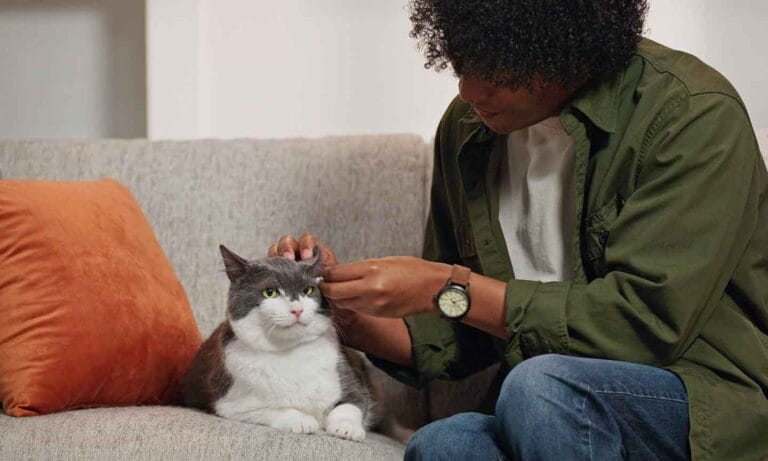Tapeworms in cats are intestinal parasites that have the potential to make kitties sick. But what are the signs of tapeworms in cats? How would you know if your cat is suffering? Don’t bug out: We’re here to help!
To truly understand tapeworms in cats, pet parents first need to understand what tapeworms are and what tricks they have up their (metaphorical) sleeve when it comes to infesting your cat. Let’s get to it.
In This Guide:
What Are Tapeworms?
Tapeworms are long, white and flat segmented worms that can live in the small intestines of cats, dogs and some other mammals. They contain both male and female reproductive organs and use their hook-like mouthparts to anchor to the inside of the intestinal wall. There are three types of tapeworms that can infect felines:
- Dipylidium caninum
- Taenia species
- Echinococcus species
All three typically use other animals, called an intermediate host, to enter a cat’s body.
Taenia and Echinococcus tapeworms can infect wild rodents and rabbits, in addition to house pets. When cats eat these infected prey animals, the parasite infects the cat. The most common tapeworm found in pet cats is Dipylidium caninum, also known as the “flea tapeworm.”
Dipylidium Tapeworm Life Cycle
This intestinal parasite has earned its “flea tapeworm” moniker because it uses a flea as an intermediate host to get into your pet.
Here’s the Dipylidium tapeworm life cycle:
1The cat ingests an adult flea that is carrying tapeworm larvae.
The cycle of infection starts when segmented tapeworm egg packets, called proglottids, are eaten by flea larvae (pre-adult fleas). These tiny flea larvae chew into the tapeworm egg case and consume the eggs inside (microscopic ova).
These eggs then hatch inside the flea larva’s body and wait there through the larva’s development into a bloodsucking adult flea. When the infected adult flea jumps on your cat, the flea is often eaten by your kitty during grooming.
2Tapeworms develop in the cat’s small intestine.
Once swallowed by your cat, the flea is digested, and the tapeworm larva is released unharmed into the cat’s small intestine, where it can then attach to the intestine wall. At this point, it takes about four weeks to grow into a reproducing adult tapeworm, which can measure anywhere from 6–23 inches and produce the segmented egg packets.
3Segments of the tapeworm’s egg-carrying tail are expelled in the cat’s poop.
These segmented egg packets contain up to 20 microscopic eggs and exit the cat’s body through their feces. Once released into the environment, they become ingested by flea larvae, and the cycle starts all over again.
Tapeworm Symptoms in Cats
Most cats do not show signs of illness from tapeworm infections.
Cats who have a heavy flea infestation are more likely to end up with large amounts of tapeworms in their intestines, and there is potential for these patients to experience the following common signs of tapeworms in cats:
- Vomiting (due to adult tapeworms becoming detached from the small intestinal wall and migrating to the stomach)
- Diarrhea
- Weight loss
- Poor appetite
You may also spot the tapeworm egg segments in your cat’s litter box or near their anus. Pale yellow and mobile, the Dipylidium proglottids come out with the cat’s feces, but the segments can also migrate from your cat’s anus without the presence of stool.
They are about a quarter of an inch long when fresh and stretched out but begin to dry after leaving the body and become more difficult to see. When dry, they somewhat resemble sesame seeds. Fresh or dry segments can occasionally be seen stuck to the fur around the cat’s anus or moving on the surface of fresh feces.
Tapeworm segments migrating to the anal area may also cause excessive anal itching, which can lead to butt scooting or constant licking of the anal area.
Rarely, a condition called Haw’s syndrome may be associated with heavy tapeworm presence in cats and cause prolapse in the third eyelids (nictitating membranes). This syndrome can occur in severely dehydrated cats, but has also been associated with significant disease of the stomach and intestines due to parasites (such as tapeworms), inflammatory bowel disease, intestinal cancer and viral enteritis. However, the absence of Haw’s syndrome does not rule out intestinal parasite infection or other intestinal disease.
Diagnosing Tapeworms in Cats
Diagnosing tapeworms in cats can sometimes be difficult. This is in part because kitties are fastidious groomers. Cats can clean the evidence from their backside and bury their stool in the litter box before anyone gets a chance to see the evidence of infection. And fecal flotations, a veterinary test used to diagnose internal parasites or worms in animals, can also come up short when trying to detect tapeworm infection due to the intermittent shedding of the egg-containing segments.
If your veterinarian finds fleas or even just the feces of fleas (aka “flea dirt”) on your cat, they will likely recommend deworming for tapeworms due to the high risk of an existing infection.
How To Treat Tapeworms in Cats
The most effective medication for killing tapeworms in cats is praziquantel. It is the only drug that is effective against all species of tapeworm. Praziquantel comes in tablet, injectable and topical forms. There is an OTC praziquantel tablet, Elanco Tapeworm Dewormer Tablets for Cats, as well as a prescription medication called Drontal. Drontal is designed to attack hookworms and roundworms. Elanco offers a praziquantel injection called Droncit, which can be administered by a veterinarian.
While one dose is considered effective to kill adult tapeworms, it is recommended to administer a second dose about two weeks later to kill any remaining or newly introduced tapeworms. Effective flea control must also be used simultaneously to clear and prevent reinfection with Dipylidium worms.
Learn more about flea control in cats.
How To Prevent Tapeworms in Cats
As the old saying goes, “An ounce of prevention is worth a pound of cure.” That certainly holds true when it comes to tapeworm infections.
Vigilant and effective flea control for your cat is the first step in preventing infection from the flea tapeworm, Dipylidium. As for the two other types of tapeworms commonly affecting cats, prevention means that kitties who go outside and hunt and consume prey, which serve as intermediate hosts for the parasites, should see their vet every three months for intestinal parasite testing and deworming, whether symptoms are present or not.
See more flea prevention treatments for cats.
FAQs About Tapeworms in Cats
Q:
Can people get tapeworms from cats?
A:Although it is uncommon, tapeworms can potentially infect people, too. The way tapeworm infections occur in humans, though, depends on the species.
The flea tapeworm, Dipylidium, must inhabit a flea to become infective, and the infected flea must be ingested by a new host for that host to become infected with the tapeworm. Therefore, if a human accidentally ingests an infected flea, they could ingest a tapeworm. This means that people cannot get a Dipylidium tapeworm infection directly from accidentally consuming tapeworm eggs from their cat’s stool or on their fur, nor from being bitten by an infected flea.
Humans can also be infected with Taenia or Echinococcus tapeworm species if they consume an infected intermediate host, such as a rodent, rabbit or livestock that is contaminated with tapeworm larvae.
According to the U.S. Centers for Disease Control and Prevention (CDC), Echinococcus is the only tapeworm species that has immediately infective eggs that do not require an intermediate host to cause infections. This means that people can become infected with Echinococcus eggs if they accidentally consume them once they are passed out of the cat or dog’s intestinal tract. Due to this, Echinococcus and Dipylidium tapeworms can more easily infect small children, as kids are generally less careful about hygiene than adults.
Q:
How serious are tapeworms in cats?
Q:
How long does it take to kill tapeworms in cats?
Q:
What happens if tapeworms go untreated in cats?
A:If a tapeworm infection goes untreated, then there is the potential for pet parents to begin seeing the typical tapeworm symptoms in cats: vomiting, diarrhea, weight loss or poor appetite.
Kittens and much older cats are especially susceptible to the adverse effects of intestinal parasites. Kittens may not thrive and, in extreme cases, can develop intestinal obstructions from adult tapeworms. Older cats are more likely to develop inflammation in their intestinal tract that can lead to chronic vomiting and weight loss. And cats of any age might resort to licking their anal areas excessively or scooting their anus on the ground due to discomfort or itching.
While tapeworms in cats should be taken seriously, they are relatively easy to treat and prevent. Effective flea control and deworming, as recommended by your veterinarian, is key. Not all flea control products are created equal and there is no deworming product that kills every type of intestinal parasite. Your veterinarian can help you choose the best treatment and prevention plan for your kitty’s lifestyle.
This content was medically reviewed by Chewy vets.
More about caring for your cat:
Share:













